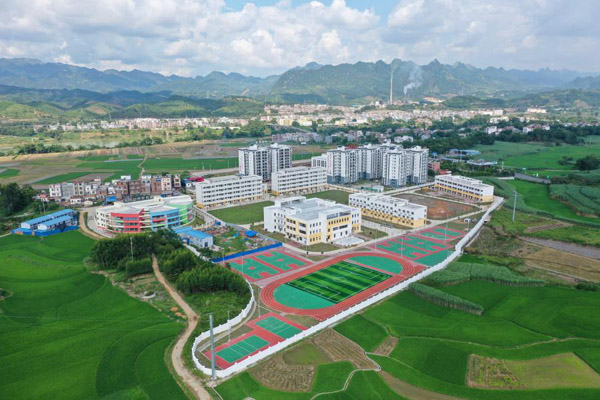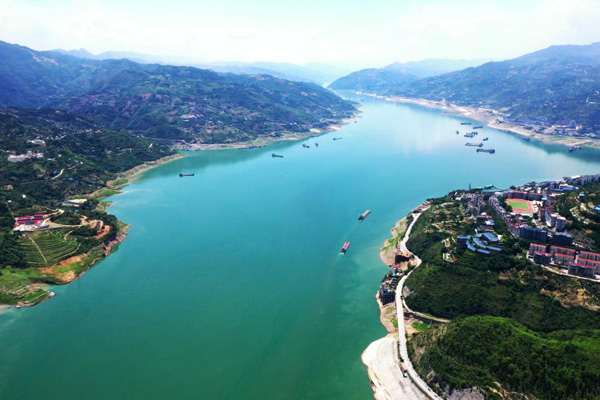China adheres to high-quality growth on journey to modernization
-- China has set a modest economic growth target for 2021, as the world's second-largest economy is experiencing fundamental changes with its development focus shifting from quantity to quality.
-- China is always committed to the people-centered philosophy of development and strives to further improve people's livelihoods through pursuing high-quality development.
-- China, in pursuit of stellar scientific and technological achievements, is upholding innovation as the central role in its modernization drive while making itself a country of innovators.
-- The government is walking a fine line between economic development and environmental protection.
by Xinhua Writers Jiang Tingting, Xie Jiang, Xuan Liqi
BEIJING -- China has set a modest economic growth target for 2021, as the world's second-largest economy is experiencing fundamental changes with its development focus shifting from quantity to quality.
"A target of over 6 percent will enable all of us to devote full energy to promoting reform, innovation and high-quality development," Premier Li Keqiang said Friday in this year's government work report submitted to the national legislature.
The annual target was significantly below the consensus of analysts, who expected growth could beat 8 percent this year.
The lower-than-expected target shows China is becoming more tolerant of moderating growth and will give provinces more room to pursue high-quality development that is more efficient, equitable, sustainable and secure, said Bai Yongxiu, a professor at Northwest University.
"Sticking to the new development concept and the high-quality growth model is a must to secure a good start for fully building a modern socialist country by 2050," said Zhang Yansheng, chief researcher of the China Center for International Economic Exchanges.
Since the 1960s, only a dozen of over 100 middle-income countries and regions have become high-income economies, as they shifted their development models from quantitative expansion to qualitative improvement. By contrast, those countries and regions that stagnated or even regressed all failed to realize this fundamental change.
"China must pursue high-quality development in order to escape the middle-income trap," said Zhang.

Aerial photo taken on Aug. 28, 2019 shows a government-led poverty-relief relocation site in Silin Township of Tiandong County, south China's Guangxi Zhuang Autonomous Region. (Xinhua/Cao Yiming)
PEOPLE-CENTERED APPROACH
One significant feature of China's modernization is to improve people's wellbeing, as evidenced by the country's herculean efforts to eradicate poverty over the past years.
China is always committed to the people-centered philosophy of development and strives to further improve people's livelihoods through pursuing high-quality development.
"The principal contradiction in Chinese society has evolved to exist between people's ever-growing need for a better life and the imbalance and inadequacy of development. High-quality development is absolutely key to resolving this contradiction," Bai said.
A series of measures will be implemented over the next five years, including increasing people's incomes, boosting employment, building a high-quality education system and improving the multi-level social security system, according to a draft outline of the 14th Five-Year Plan (2021-2025) for national economic and social development and the long-range objectives through the year 2035.
"Chinese people will receive greater and more equitable benefits from reform and development and enjoy more substantial, assured and lasting feelings of fulfillment, happiness and security as China makes constant strides toward the goal of common prosperity," Bai said.

A research team including Chinese quantum physicist Pan Jianwei established a quantum computer prototype, named "Jiuzhang," via which up to 76 photons were detected, the team announced on Dec. 4, 2020. (Xinhua)
STRENGTHENING INNOVATION
China, in pursuit of stellar scientific and technological achievements, is upholding innovation as the central role in its modernization drive while making itself a country of innovators.
China should step up efforts to strengthen innovation capacity with a greater emphasis on basic research and original creation, said Lei Jun, a deputy to the 13th National People's Congress (NPC) and founder and CEO of Xiaomi, a leading smartphone manufacturer.
"I believe the country's science and technology industries will show greater vitality with the implementation of the measures mentioned in the draft," Lei said.
Li Daokui, a national political advisor and an economist with Tsinghua University, said technological innovation is key to expediting industrial upgrading, and China still faces bottlenecks in some core technologies in key fields.
"Years of entrepreneurial experiences make us realize that science and technology constitute a primary productive force," said Xu Guanju, an NPC deputy and president of Transfar Group, a chemical company in east China's Zhejiang Province.
Xu said his company's continuous investment in innovation has paid off. "Through a slew of innovative technologies, our labor productivity rose by 25 percent, and production management costs fell by the same amount."
China pledged more efforts to enhance enterprises' innovation capacity, stimulate the vitality of talent for innovation and make institutional improvements in sci-tech innovation during the 14th Five-Year Plan period.
China's R&D spending will increase by more than 7 percent per year over the next five years, accounting for a higher percentage of GDP than that in the past five years, according to the draft outline.

Aerial photo taken on June 12, 2020 shows workers installing an offshore wind turbine at a wind farm in Fuqing, southeast China's Fujian Province. (Xinhua/Lin Shanchuan)
GREEN GROWTH
Despite increasing downward pressure over the years, China has been steadfast in resisting the old ways of economic expansion, which severely affected the environment, as leadership repeatedly underscored that "lucid waters and lush mountains are invaluable assets."
Pursuing an eco-friendly growth pattern, China has taken stringent measures to promote the wider use of renewable energy, cut the production capacity of resource-intensive sectors and wage a battle against pollution.
Even faced with unprecedented headwinds from COVID-19 in the past year, the country did not lessen its efforts toward green development as it initiated a total ban on importing solid waste and a 10-year fishing ban along the Yangtze River.
"This year, China will continue to intensify efforts to improve the environment," Premier Li said in the report.

Aerial photo taken on May 29, 2020 shows the view of Qutang Gorge, one of the Three Gorges on the Yangtze River, in southwest China's Chongqing. (Xinhua/Wang Quanchao)
The ban on the importation of solid waste will remain in place, the urban household waste sorting will be promoted in a well-planned way, the use of eco-friendly express delivery packaging will be encouraged and the collection and treatment of hazardous waste and medical waste will be improved, according to the report.
Besides, the government will draw up an action plan for peaking carbon emissions before 2030 and make efforts to improve its industrial structure and energy mix.
That shows the government is walking a fine line between economic development and environmental protection, said Zhu Ning, a professor at Shanghai Jiao Tong University.
It can be viewed that green development will be elevated to a higher position in the country's modernization drive, according to Cui Zhenhai, a research fellow with Chongyang Institute for Financial Studies at Renmin University.
- Chinese president appoints new ambassadors
- Top legislature schedules upcoming session in October
- China's top legislator meets Liberian senate president pro tempore
- China's top legislator meets Cambodia's National Assembly president
- China urges Group of Friends of Neutrality members to reform and improve global governance



